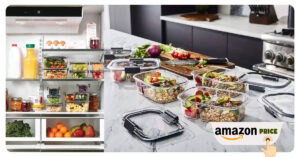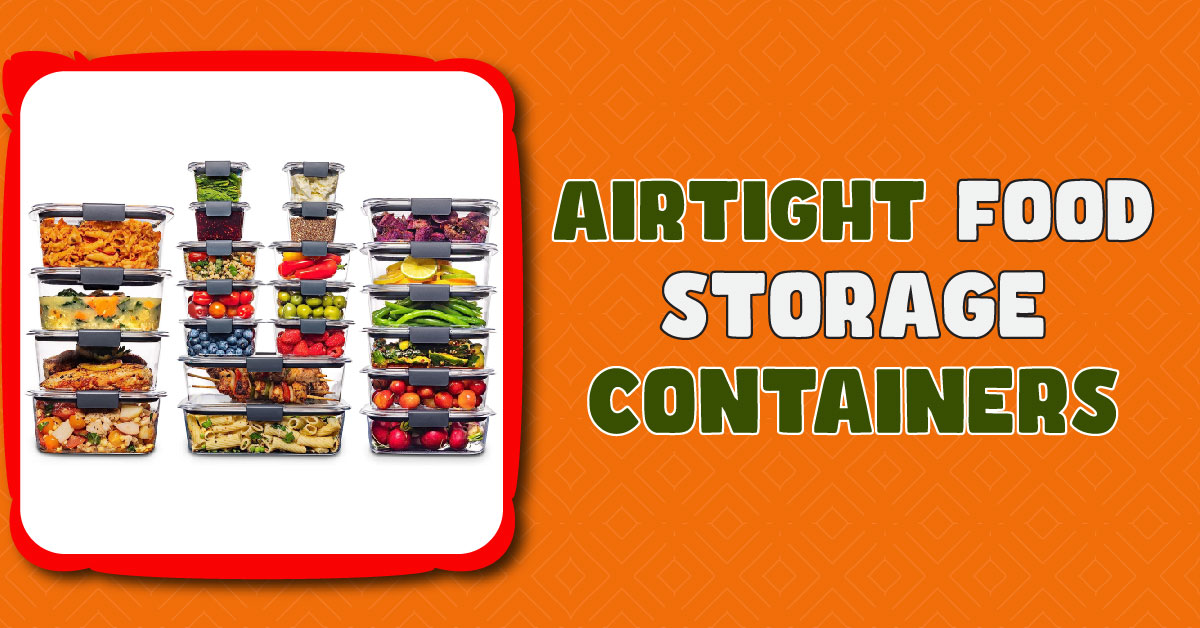Have you ever opened a bag of chips only to find them stale? Or stored leftovers and ended up with a messy spill in your fridge? I know the struggle! That’s why I love airtight food storage containers. They keep food fresh, stop leaks, and make any kitchen look neat. Whether you’re meal prepping, organizing your pantry, or wondering what is an airtight container and why it matters, I’ve got you covered. In this guide, I’ll share my best tips and real-life experiences to help you pick the right ones. Let’s dive in!
What Are Airtight Food Storage Containers?
Ever stored crackers in a container, only to find them soft the next day? That’s the problem with air exposure! It makes food stale, soggy, or even mouldy. Airtight food storage containers fix this. They lock out air and moisture, keeping food fresh longer.
These containers have tight seals—thanks to rubber gaskets, snap lids, or vacuum locks. This keeps food from drying out, losing flavour, or absorbing bad smells. They’re perfect for flour, pasta, coffee, and leftovers.
Think of them as food armour. They block humidity, bugs, and spills. They also stop leaks, making them great for soups and sauces. You’ll find them in food-grade plastic containers, glass jars, and stainless steel options.
Benefits of Airtight Food Storage Containers
Ever thrown out stale bread or found bugs in your flour? Airtight food storage containers solve these problems. They keep food fresh, stop spills, and make your kitchen more organized.
1. Keep Food Fresh Longer
Air and moisture ruin food. Airtight containers seal in freshness. Your chips stay crispy, your coffee holds its flavor, and your leftovers taste just as good the next day.
2. Prevent Leaks & Spills
Ever had a soup leak in your bag? Leak-proof airtight containers stop that mess. They work great for meal prep, lunches, and storing liquids without spills.
3. Keep Bugs Out
Pantry pests love dry foods like rice and flour. Airtight food storage containers keep them out. No more ants in sugar or weevils in grains!
4. Save Space & Stay Organized
Half-open bags spill everywhere. Stackable airtight containers make storage easy. They save space, keep shelves neat, and help you find things fast.
5. Reduce Food Waste
Spoiled food is wasted money. Proper storage keeps food fresh longer. You’ll save money and make fewer trips to the store.
Choosing the Right Food Storage Containers
Picking the best food storage containers can feel overwhelming. Glass or plastic? Round or square? Airtight or vented? I’ve been there! After trying different types, I’ve learned what works—and what doesn’t.
1. Glass vs. Plastic: Which One Wins?
Plastic is cheap and lightweight, but glass is safer, more durable, and better for the environment. It won’t absorb odors or stain like plastic does. Plus, no worries about chemicals like BPA. If you want long-lasting, healthier storage, glass is the way to go.
2. Airtight or Regular?
If you’re storing dry goods like flour, sugar, or snacks, airtight is a must. It keeps food fresh and stops moisture, bugs, and spills. But for short-term fridge storage, a simple glass container with a snap-on lid works fine.
3. Round or Square?
Square containers save more space and stack better in the fridge or pantry. Round ones are great for liquids and soups since they have fewer corners for food to get stuck in.
4. What About Lids?
Lids matter more than you think! Plastic lids are common, but silicone or glass lids last longer. Locking lids prevent leaks, while vented lids make microwaving safer. If you’re meal-prepping or storing sauces, go for leak-proof locking lids.
5. Can It Go in the Freezer, Microwave, or Oven?
Not all containers are made for extreme temperatures. Borosilicate glass is best for freezing and baking because it handles temperature changes well. Regular glass may crack if it goes from the freezer to a hot oven. Always check labels to be safe!
Types of Glass Food Containers
Not all glass food containers are the same. Some work best for meal prep, while others are perfect for pantry storage. Choosing the right type can make your life easier and your kitchen more organized. Let’s break down the options!

Get latest offer at amazon
1. All-Glass Food Containers
What they are: These are made entirely of glass, including the lids.
Why you’ll love them: They are 100% recyclable, chemical-free, and don’t absorb odours. If you want a plastic-free kitchen, these are a great choice.
2. Glass Food Containers with Lids
What they are: These come with plastic, silicone, or glass lids for sealing in freshness.
Best for: Leftovers, meal prep, and fridge storage. If you need leak-proof options, go for ones with airtight locking lids.
3. Stackable Glass Storage Containers
What they are: Space-saving containers designed to nest or stack neatly.
Why you’ll love them: They keep your kitchen tidy and make it easy to see what’s inside. No more messy shelves or lost lids!
4. Glass Pantry Storage Containers
What they are: Clear glass jars for storing dry goods like flour, rice, pasta, and spices.
Why they’re great: You can see everything at a glance, plus they keep food fresh and safe from bugs.
5. Lock-and-Lock Glass Containers
What they are: Containers with secure, snap-on lids that prevent leaks and spills.
Best for: Traveling, meal prep, and storing liquids like soups or sauces. If you pack lunches or carry food on the go, these are a lifesaver!
6. Glass Bottles with Glass Lids
What they are: Glass bottles used for storing drinks, oils, dressings, or homemade sauces.
Why you need them: They keep liquids fresh and are a safer, reusable alternative to plastic bottles.
Best Glass Food Containers for Different Needs
Not all glass containers are the same. Choosing the right one depends on how you use it. Need something for meal prep? Pantry storage? Freezing leftovers? Let’s find the best fit!
1. Best for Meal Prep & Leftovers
Pick: Airtight, leak-proof containers with compartments.
Why? They keep food fresh and stop spills. If you prep meals ahead, choose stackable, portioned containers for easy storage. Glass is also microwave-safe, so you can reheat without worry.
2. Best for Pantry Storage
Pick: Clear glass jars with tight lids.
Why? Pantry staples like flour, rice, and pasta stay fresh longer in airtight containers. Plus, clear glass lets you see what’s inside—no more digging for sugar!
3. Best for Freezing
Pick: Borosilicate glass containers with freezer-safe lids.
Why? Not all glass can handle freezing! Borosilicate glass is stronger and resists cracking. Always leave space for food to expand to prevent breakage.
4. Best for Microwave Use
Pick: Microwave-safe glass with vented lids.
Why? Glass is safe for microwaves, but lids matter! Vented lids stop pressure buildup. Avoid sudden temperature changes to prevent cracks.
Things to Consider When Buying Glass Food Containers
Buying the right glass food container is more than just picking a pretty one. Different features make a big difference! Here’s what to check before you buy.
1. Material Quality: Borosilicate vs. Soda-Lime Glass
Not all glass is the same! Borosilicate glass is heat-resistant and strong. It won’t crack with sudden temperature changes. Soda-lime glass is cheaper but less durable. If you plan to freeze or bake, borosilicate is the better choice.
2. Lid Type: Plastic, Silicone, or Glass?
Lids matter more than you think! Plastic lids are common but can wear out. Silicone lids are flexible and create a tight seal. Glass lids are eco-friendly but can be heavier. For travel or liquids, choose leak-proof, locking lids.
3. Size & Shape: Round vs. Square
Square containers save space and stack neatly. Round ones work better for soups and liquids since they mix evenly. If you meal prep, pick stackable, same-size sets.
4. Microwave, Oven & Freezer Safety
Wondering “Can you microwave glass food containers?” Yes! But always check if they’re microwave-safe. Not all glass works in ovens or freezers. Avoid sudden temperature changes to prevent cracks.
5. Easy Cleaning & Stain Resistance
Nobody likes scrubbing stains! Dishwasher-safe containers make cleanup easier. Look for stain-resistant glass to keep them looking new. Pro tip: If a lid has a rubber seal, remove and wash it to prevent mould.
What I Like
Using glass food containers has changed how I store food. They keep meals fresh, make my kitchen look neat, and feel safer than plastic. Here’s why I love them:
Keeps Food Fresh Longer – No more stale snacks or soggy leftovers. The tight seal locks in freshness, so food tastes great the next day.
Safe & Non-Toxic – Glass doesn’t hold smells or stains. Plus, no worries about harmful chemicals like BPA.
Versatile & Easy to Use – I use them in the freezer, microwave, and oven. That means fewer dishes to clean!
Strong & Durable – Unlike plastic, these don’t warp, stain, or scratch. Mine still look brand new after months of use.
Simple to Clean – They’re dishwasher-safe and don’t trap odours. No need to scrub endlessly.
What Could Be Better
I love my glass containers, but nothing is perfect. These aren’t dealbreakers, but here’s what could improve:
A Bit Heavier Than Plastic – Glass is sturdy, but it does add weight. If you carry lunch often, you might feel the difference.
Can Break If Dropped – They’re durable but still glass. I handle them carefully, but accidents can happen.
Lids May Wear Out – Over time, plastic or silicone lids might need replacing. Thankfully, many brands sell extras.
My Personal Experience
I’ve used glass food containers for over two years. They make meal prep simple, keep my pantry organized, and help my food stay fresh. Here’s my take on their design, performance, and build quality.
Design
The clear and simple design makes it easy to see what’s inside. No more mystery meals in the fridge! Many containers stack well, so they save space. They also look great in my pantry—way better than random plastic lids everywhere.
Performance
These containers keep food fresh and prevent leaks. I’ve stored soups, sauces, and smoothies without spills. The airtight seals work well, and my food stays fresh longer. Whether I meal prep or store leftovers, they never let me down.
Build Quality
The thick glass feels strong and solid. Unlike plastic, it doesn’t warp, stain, or hold smells. I’ve used them in the oven, microwave, and freezer without cracks. Some brands use borosilicate glass, which can handle high and low temperatures. These containers are built to last, and I don’t see myself replacing them anytime soon.
Conclusion
Switching to glass food containers is a small change with big benefits. They keep food fresh, last longer than plastic, and are safer for your health. Plus, they look great in any kitchen!
If you meal prep, store dry goods, or just want an organized fridge, the right glass container makes life easier. Pick strong borosilicate glass, airtight lids, and stackable shapes to fit your needs.
FAQs
Can you freeze glass food containers?
Yes! Just leave space for food to expand. Sudden temperature changes can cause cracks.
Are glass food containers better than plastic?
Yes! They are safer and last longer. Plus, they don’t stain or hold odours like plastic.
Do glass food containers break easily?
Not really! Most are strong and heat-resistant. But, like any glass, they can crack if dropped.
Are glass food containers microwave-safe?
Yes! Most are safe for microwaves. Just check the label and avoid sudden heat changes.
What’s the best way to store glass containers?
Stack them neatly or use dividers. Many are designed to nest, saving space in your kitchen.

